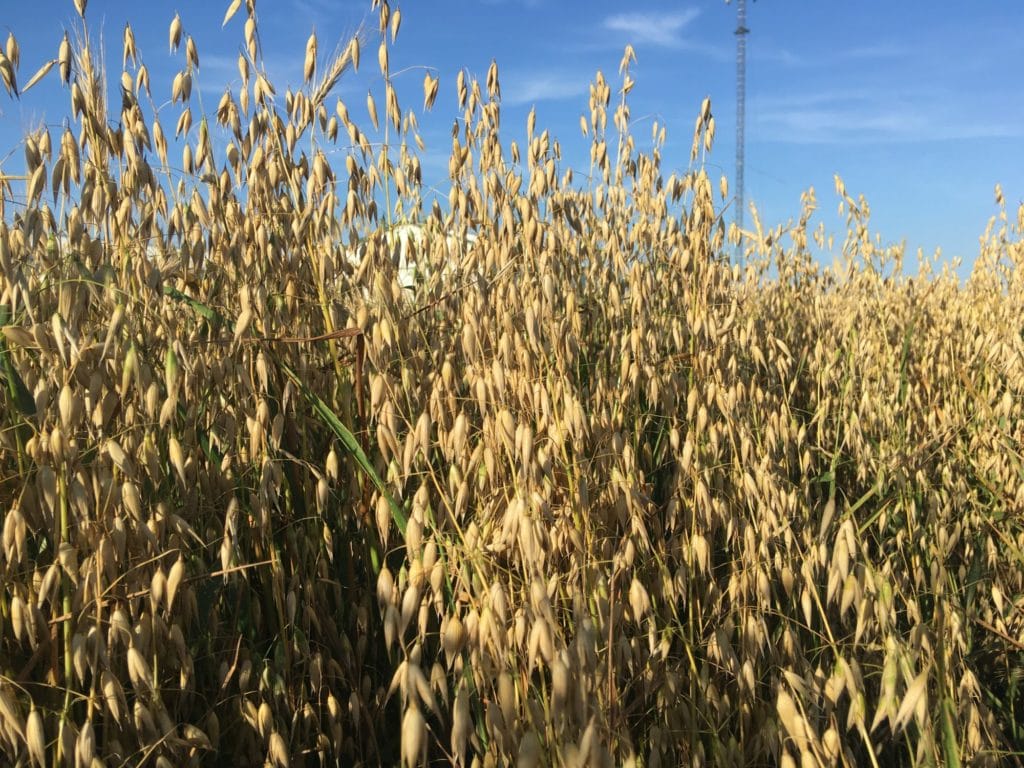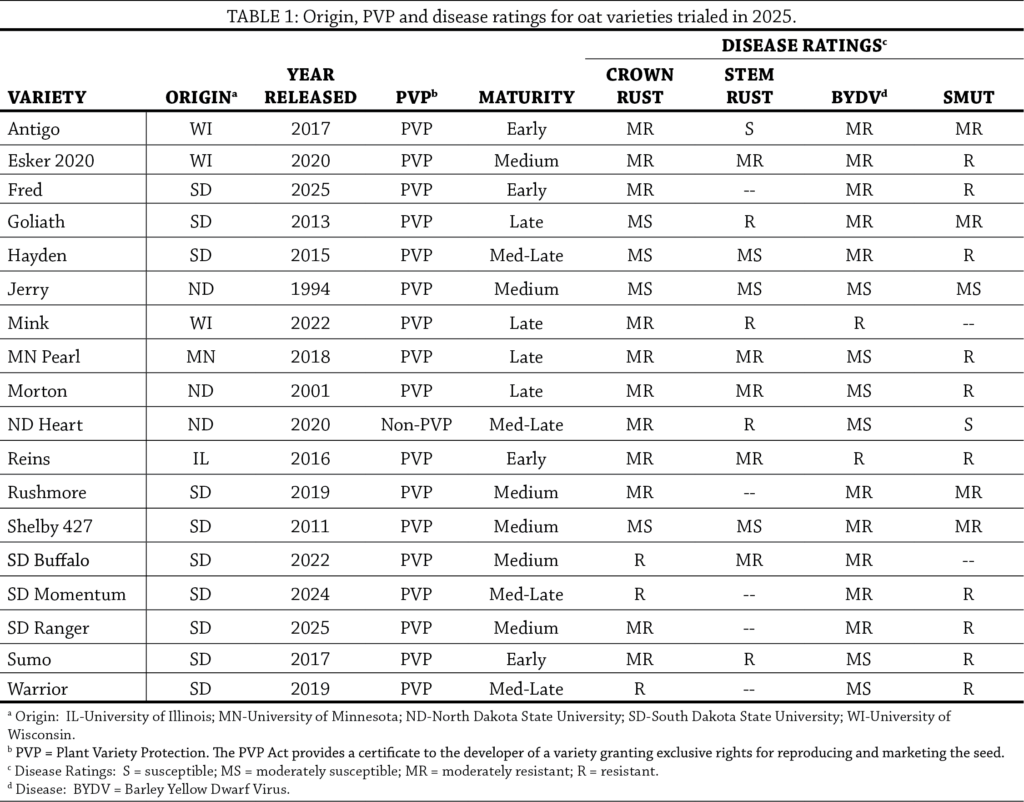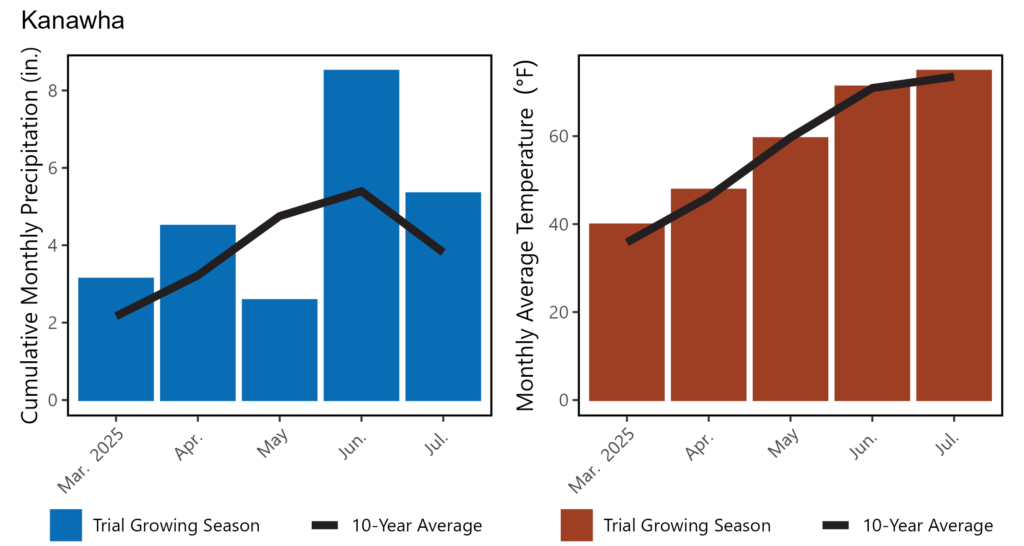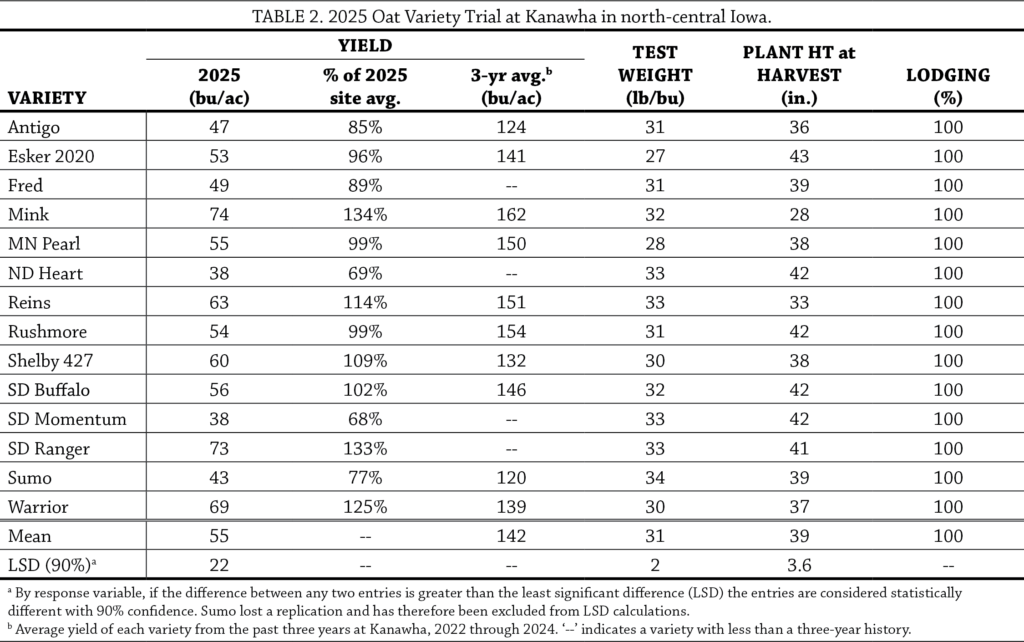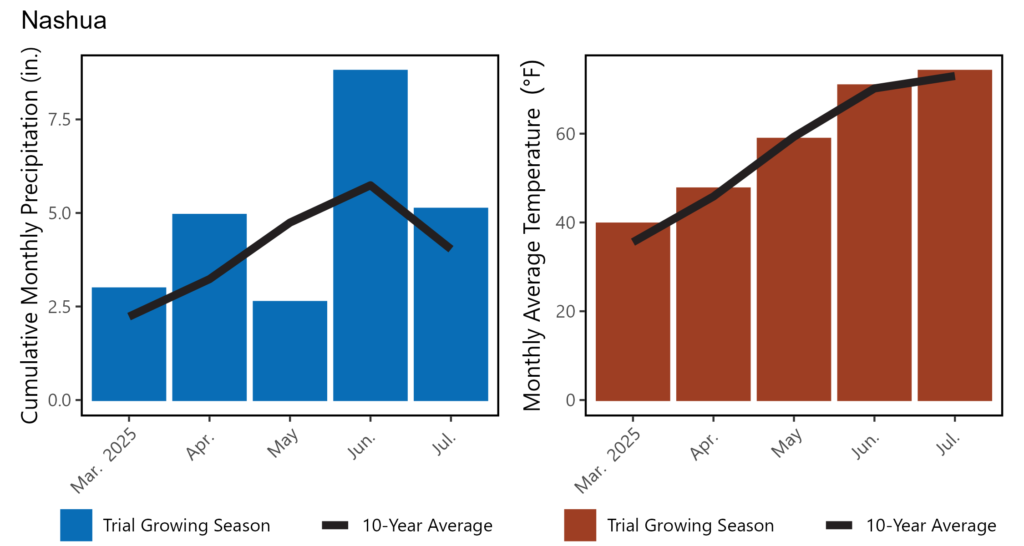This research was funded by USDA-NIFA, Walton Family Foundation, Albert Lea Seed House, Welter Seed and Honey Co., SDSU Seed Foundation, UW Foundation Seeds and Zabel Seeds.
In a Nutshell:
- 18 oat varieties were screened at two Iowa State University research farms.
Key Findings:
- Across varieties and sites, average oat yield was 125 bu/ac and average test weight was 32.5 lb/bu.
- Esker 2020 scored the highest grain yield, Antigo scored the highest test weight, both of these occurring at Nashua in notheast Iowa.
Background
Oats have low input requirements and beneficial effects on succeeding crops in a rotation. They can be used for grain and straw production, as a companion crop to establish hay and pastures, or for early-season forage as hay or haylage. Because of their relatively short growing season, oat production enables numerous field management options for the remainder of the season.
Although oat production has increased in Iowa in recent years, in 2025, only 120,000 acres of oats were planted in Iowa, according to the USDA-National Agricultural Statistics Service’s projections [1]. This is down from 210,000 acres in 2024 and is the lowest planted acreage production in five years. This decrease may be partially attributed to lower prices per bushel, which have slipped by half since the record-high prices of winter 2021-22.
Average oat yield in Iowa in 2025 was 80 bu/ac. This is very close to the average yield of the previous 3 years of 81 bu/ac [1].
Oat grain and straw yield and attributes, like lodging propensity, can vary by variety and growing conditions. This means that oat variety trials at sites across the state are important tools for farmers who grow oats. Since 2015, PFI has helped organize oat and other small grains variety trials at Iowa State research farms around the state. Four sites participated this year, but only two sites—Kanawha and Nashua—were able to gather data due to heavy rains and high rates of lodging and weeds at sites in Boone and Greenfield.
Methods
Variety trials were conducted at two locations in 2025: ISU Northern Research Farm in Kanawha and ISU Northeast Research Farm in Nashua. These variety trials build on previous trials conducted at Kanawha, Charles City, Boone, Nashua and Greenfield from 2015–2024 [2 – 11]. Information about each of the varieties grown in these trials in 2025 can be found in Table 1.
Oat management information is provided with the results from each location. No herbicides or insecticides were applied at any location during the oat growing season. Statistical significance is determined at 90% confidence level and means separations are reported using Fishers’ Least Significant Difference Test (LSD). Data were analyzed by location, and varieties are listed in alphabetical order at each location. Reported yields are corrected for 13.5% moisture. Rainfall and temperature data were modeled for the site location from NASA weather data by the NASA-power climatology R package [12, 13].
Results and Discussion
Test strips in the oat variety trials generally overperform national and state averages for bushels per acre. The 2025 average yield in the US nationally was 76 bu/ac and Iowa was 80 bu/ac [1]. Nashua yielded 154% of the state average, with 123 bu/ac as a site average across varieties (Table 3). Nashua’s yield was very similar to recent years; four bushels lower per acre than the average site average from the last three years (2022 through 2024). In 2025, Kanawha’s yields were less than half those of recent years, with a site average of 55 bushels per acre (Table 2). This was due to very heavy rains (see weather figure below), and an assessed 100% lodging rate. Even with the losses from lodging, Kanawha’s 55 bu/ac is 74% of the national average and 69% of the Iowa state average in 2025. Nashua was harvested 25 days earlier than Kanawha, leading to much lower rates of lodging and yield losses.
There were significant varietal differences in yield at each site. Mink and SD Ranger yielded relatively well at Kanawha, both producing over 70 bu/ac. At Nashua, Esker 2020, SD Ranger, and Buffalo all yielded above 140 bu/ac. ND Heart and SD Momentum produced less than 40 bu/ac at Kanawha. Morton and Jerry were the lowest producers at Nashua; at 101 and 95 bu/ac respectively, they were in the lowest LSD grouping.
Test weight for food-grade oats is 38 lb/bu. In 2025, none of the varieties reached test weight at either site. Last year (2024), five varieties reached test weight at Nashua and one reached test weight at Kanawha.
Nashua measured straw tons per acre: SD Momentum produced the most straw. At 2.8 tons per acre, it produced significantly more straw than any other variety.
SD Ranger, a new variety released by South Dakota State University in 2025, performed well at both sites. It was in the top LSD groups for yield at both sites. It had test weights of 33 and 34 lb/bu at Kanawha and Nashua, respectively. It yielded 2.0 tons of straw per acre at Nashua. SDSU suggests that it could replace Rushmore. In our tests, SD Ranger yielded more bushels per acre at both sites, a higher test weight at Kanawha but lower at Nashua, and more straw at Nashua, compared to Rushmore.
ISU Northern Research Farm, Kanawha
Previous crop: Soybeans
Replications: 3
Harvested plot size: 5 ft × 49.5 ft
Fertilizer applied: 360 lb K/ac as potash in fall 2024; 17 lb S/ac as gypsum on Apr. 8, 2025; 39 lb N/ac as UAN(28) on Apr. 9, 2025
Planting date: April 11, 2025
Row spacing: 7.5 in.
Seeding rate: 4 bu/ac
Seeding depth: 1 in.
Harvest date: Aug. 11, 2025
ISU Northeast Research Farm, Nashua
Previous crop: Soybeans
Replications: 3
Harvested plot size: 8.125 ft x 125 ft
Fertilizer applied: 30 lb N/ac as urea on March 27, 2025
Tillage: Field cultivator to incorporate urea on March 27, 2025
Planting date: March 28, 2025, followed by cultipacking
Row spacing: 7.5 in.
Seeding rate: 4 bu/ac
Seeding depth: 1.5 in.
Harvest date: July 17, 2025
Straw Harvest date: July 18, 2025
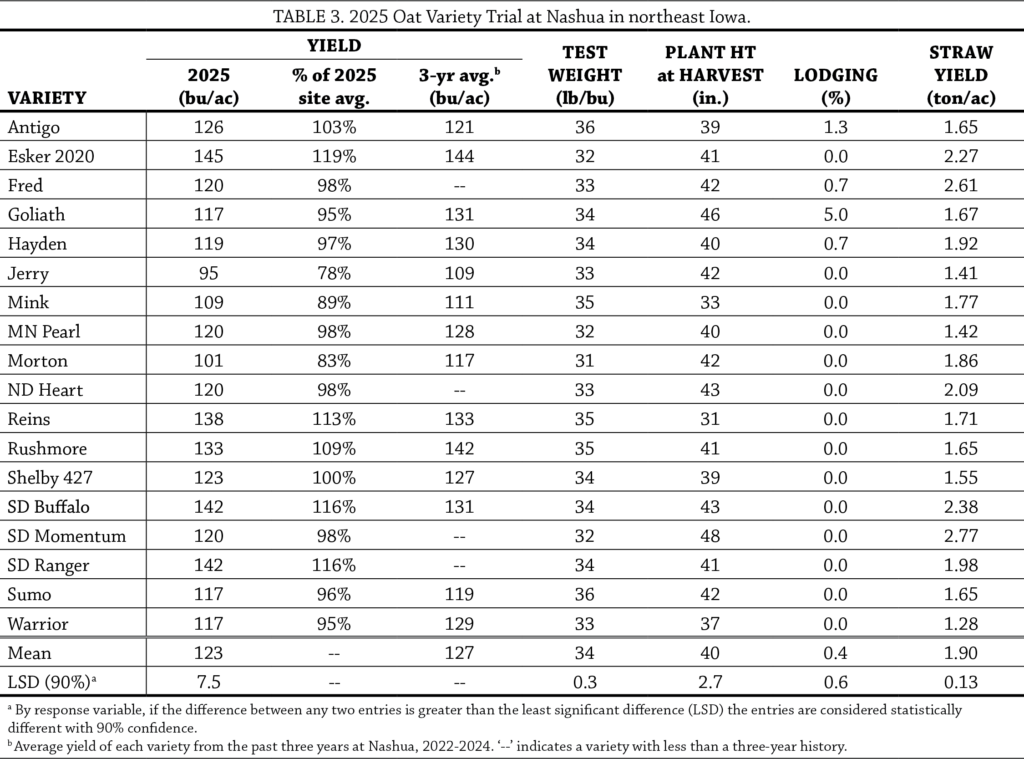
Funding Acknowledgement
This work is supported by the Agriculture and Food Research Initiative, grant number F9000315202081 from the USDA National Institute of Food and Agriculture. Any opinions, findings, conclusions, or recommendations expressed in this publication are those of the author(s) and do not necessarily reflect the views of the U.S. Department of Agriculture.
We would also like to express our gratitude to Albert Lea Seed House, Welter Seed and Honey Co., Zabel Seeds, South Dakota State University Seed Foundation and University of Wisconsin Foundation Seeds for donating seed for these variety trials.
References
[1] “USDA/NASS QuickStats Ad-hoc Query Tool.” Accessed: Sep. 11, 2024. [Online]. Available: https://quickstats.nass.usda.gov/
[2] S. Gailans and S. Carlson, “Oat Variety and Fungicide Trials,” Practical Farmers of Iowa. Accessed: Sep. 11, 2024. [Online]. Available: https://practicalfarmers.org/research/oat-variety-and-fungicide-trials/
[3] S. Gailans and S. Carlson, “Oat Variety Trials 2016,” Practical Farmers of Iowa. Accessed: Sep. 11, 2024. [Online]. Available: https://practicalfarmers.org/research/oat-variety-trials-2016/
[4] S. Gailans and S. Carlson, “Oat Variety and Fungicide Trials 2017,” Practical Farmers of Iowa. Accessed: Sep. 11, 2024. [Online]. Available: https://practicalfarmers.org/research/oat-variety-and-fungicide-trials-2017/
[5] S. Gailans, “Oat Variety Trial 2018,” Practical Farmers of Iowa. Accessed: Sep. 11, 2024. [Online]. Available: https://practicalfarmers.org/research/oat-variety-trial-2018/
[6] S. Gailans and S. Carlson, “Oat Variety Trial 2019,” Practical Farmers of Iowa. Accessed: Sep. 11, 2024. [Online]. Available: https://practicalfarmers.org/research/oat-variety-trial-2019/
[7] S. Gailans and L. English, “Oat Variety Trial 2020.” Accessed: Sep. 11, 2024. [Online]. Available: https://practicalfarmers.org/research/oat-variety-trial-2020/
[8] S. Gailans and L. English, “Oat Variety Trial 2021,” Practical Farmers of Iowa. Accessed: Sep. 11, 2024. [Online]. Available: https://practicalfarmers.org/research/oat-variety-trial-2021/
[9] S. Gailans, “Oat Variety Trial 2022,” Practical Farmers of Iowa. Accessed: Sep. 11, 2024. [Online]. Available: https://practicalfarmers.org/research/oat-variety-trial-2022/
[10] S. Gailans and E. Link, “Oat Variety Trial 2023,” Practical Farmers of Iowa. Accessed: Sep. 11, 2024. [Online]. Available: https://practicalfarmers.org/research/oat-variety-trial-2023/
[11] A. Sparks, nasapower: NASA-POWER Data from R. (2024). [Online]. Available: https://CRAN.R-project.org/package=nasapower
[12] A. H. Sparks, “nasapower: A NASA POWER Global Meteorology, Surface Solar Energy and Climatology Data Client for R,” J. Open Source Softw., vol. 3, no. 30, p. 1035, Oct. 2018, doi: 10.21105/joss.01035.
[13] A. Sparks, nasapower: NASA-POWER Data from R. (2024). [Online]. Available: https://CRAN.R-project.org/package=nasapower


